Makita DTM50RM1J1 Review
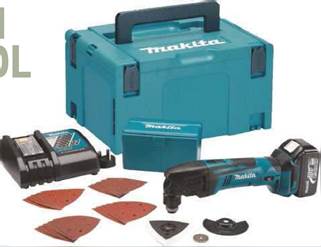
Supplied with a MakPac carry case and a multitude of accessories, this cordless multi-tool from Makita benefits from a robust build quality and is able to work in awkward spaces, says Phil Davy. Read our Makita DTM50RM1J1 Review.

The term multi-tool can be slightly misleading, implying that it’s the Swiss Army knife of power tools. Although you can obviously sand, saw and scrape, there’s not a huge amount more you can do with an oscillating multi-tool, however. It’s more to do with the variety of materials that can be cut or abraded – wood, metal, plasterboard, masonry – that best sums up its function. That and its ability to work in awkward spaces, such as sanding tight into corners or cutting through architrave when laying timber flooring. That’s not to deny it’s a useful product across a wide range of tasks, and it’s a favourite tool with bathroom fitters. When sanding painted woodwork before decorating, I usually reach for a multi-tool, particularly where surfaces are poor. The triangular pad makes life a lot easier when preparing skirting and architrave especially.
Storage & accessories
This new multi-tool from Makita is a no-frills,
18V battery version, available in several options depending on whether or not you already have
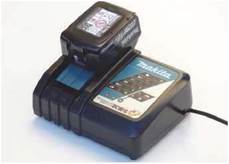
This particular kit includes a fast charger and one 4.0Ah battery, which will give around 50 minutes of sanding time
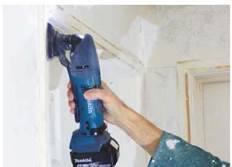
For horizontal use this isn’t a bad thing, though for vertical sanding I found myself supporting it with both hands after a few minutes
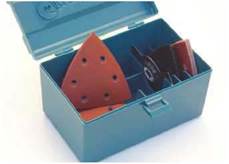
A smaller box is included for the various accessories supplied, which consist of a triangular backing pad and 20 sanding sheets (60, 80, 120 and 180 grit)
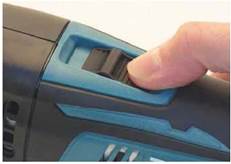
Mounted centrally, the on/off slider switch is convenient whether you’re right- or left-handed
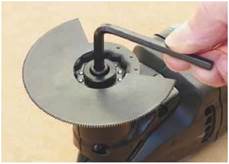
There’s also an 85°, semi-circular cutting blade for wood and metal
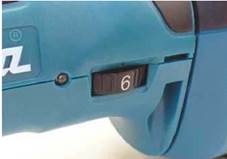
Towards the rear of the tool is a ribbed speed dial, which has a click action as you adjust
Makita cordless products. This particular kit includes a fast charger and one 4.0Ah battery, which will give around 50 minutes of sanding time. If you’re unfamiliar with Makita batteries, they feature a red LED ladder display to indicate remaining capacity.
Packed in a capacious MakPac storage case, you could easily stow a drill or other tool here as well, handy for site work. A smaller box is included for the various accessories supplied, which consist of a triangular backing pad and 20 sanding sheets (60, 80, 120 and 180 grit). There’s also an 85°, semi-circular cutting blade for wood and metal.
Ergonomics
Immediately noticeable when you pick up the DTM50 is its bulk, a reflection of the robust build quality. With a 4.0Ah battery fitted the tool weighs 2.1kg, not exactly lightweight. For horizontal use this isn’t a bad thing, though for vertical sanding I found myself supporting it with both hands after a few minutes.
Encased in the usual plastic shell, there’s limited soft-grip rubber around the palm area,
though most of this surrounds the front end of the tool. Mounted centrally, the on/off slider switch is convenient whether you’re right- or left-handed. Soft-start electronics mean there’s no sudden kick when you fire it up, though this is rarely a problem with a multi-tool.
A white LED worklight is activated when the tool is switched on, a welcome addition where lighting is less than ideal. Apparently this will flash and the DTM50RM1J1 shuts down if overload should occur, though it kept going without any problems during testing.
Towards the rear of the tool is a ribbed speed dial, which has a click action as you adjust, so it’s difficult to alter the setting accidentally. Speed range is from 6,000-20,000opm, with an oscillation angle of 3.2°, which is fairly standard.
A red warning LED alongside the dial starts flashing when there’s about five minutes of life remaining in the battery. This may seem a bit over the top, but it’s quite handy if you’ve forgotten
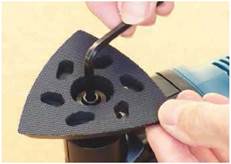
An 85mm rubber sanding pad is standard, attached to the head with a hex screw and washer
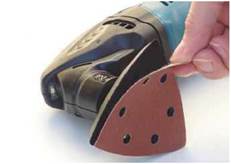
The pad accepts hook-and-loop sanding sheets, as you’d expect
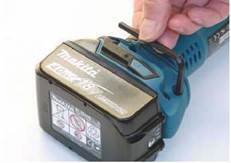
There’s no quick-release, tool-free locking here, though the hex key included is stored neatly at the base
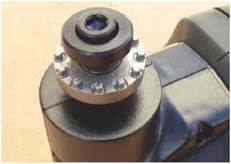
Accessories use the OIS interface and with a universal adaptor thrown in, most blades should fit
to recharge that second battery. Older Makita batteries don’t have an LED display to indicate capacity, so this feature makes sense.
Fixed head
An 85mm rubber sanding pad is standard, attached to the head with a hex screw and washer. The pad accepts hook-and-loop sanding sheets, as you’d expect. There’s no quick-release, tool-free locking here, though the hex key included is stored neatly at the base. Actually changing the angle of a blade or pad is straightforward, with no need to remove the screw completely. Once tightened up, everything remains rock solid.
Accessories use the OIS interface and with a universal adaptor thrown in, most blades should fit. There’s a Makita Starlock pad available as an option if you prefer. Although only one toothed steel blade is provided it’s effective in softwood, though tougher going in hardwood.
The extraction system is quite elaborate and consists of four plastic components, which fit together. Once dust is sucked up through the six holes in the pad it passes through a plastic tube underneath the tool. This is clipped underneath, ending in a 25mm diameter port for connecting a vacuum extractor. To ensure maximum dust is collected a collar surrounds the shaft behind the sanding pad. This fits over the shaft, together with a felt insert to seal any gaps. It does a pretty good job, though the tube adds to the bulkiness of the tool, noticeable with small hands.
Conclusion
I found the Makita became fairly warm after a time, possibly because my left hand was partly obscuring the cooling vents. I’m used to Ryobi’s multi-tool with a tilting head, so the Makita is more limited in that respect. Sanding architrave around several doors and bullnose skirting could be awkward, though expect that with any fixed- head tool. With an extractor hooked up it becomes an efficient sander, though slightly cumbersome.
If you already have Makita batteries, this heavy-duty tool is available bare for around £, making it excellent value. No extraction kit is included at this level, though.

Although only one toothed steel blade is provided it’s effective in softwood, though tougher going in hardwood
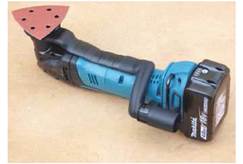
Once dust is sucked up through the six holes in the pad it passes through a plastic tube underneath the tool
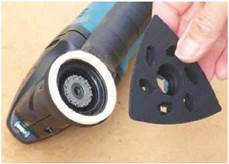
A collar fits over the shaft, together with a felt insert to seal any gaps
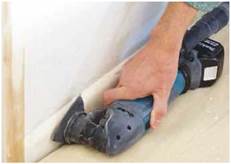
With an extractor hooked up it becomes an efficient sander, though slightly cumbersome
SPECIFICATION
Battery type: Lithium-ion Voltage: 18V Oscillation angle: 3.2°
Oscillations per minute: 6,000-20,000 Vibration K factor: 1.5m/sec2 Vibration: Cutting metal – 5m/sec2; cutting wood – 9.5m/sec2; chiselling – 7.5m/sec2; sanding – 2.5m/sec2 Weight: 1.8-2.2kg
Kit contents: Makita DTM50RM1J1 cordless multi-tool; BL1840 18V Li-ion battery; DC18RC compact charger; MakPac connector case (type 3); inner tray; Hex wrench; dust extraction attachment; accessory set; B-21537 sanding pad; P-21624 60 grit wood x 5; P-21630 80 grit wood x 5; P-21646 120 grit wood x 5; P-21652 180 grit wood x 5; B-21325 85mm seg blade; universal adaptor
Web: www.makitauk.com





